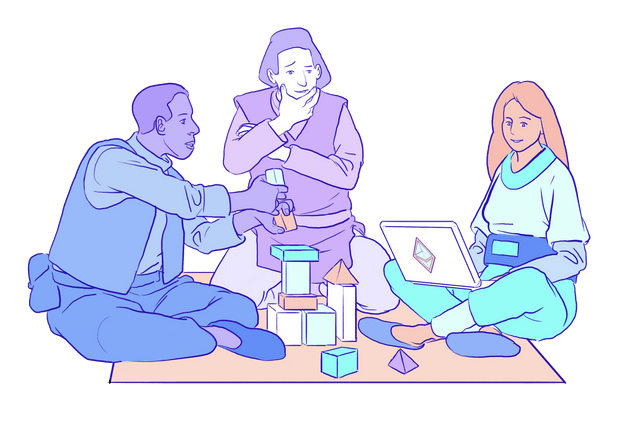The tenth principle of systems science states that sufficiently complex adaptive systems can contain internal models of themselves. This piece will briefly define self-models, and then examine how Ethereum’s model of itself influences its current dynamics and evolution over time.
Self-models
Self-models are internally held models that are used by systems capable of thinking about themselves and their roles. Just like external models of the environment, these internal models serve as functional protocols which guide the system’s interactions. They can be detailed, abstract, accurate, or inaccurate.
For humans, these self-models exist as ideas and self-conscious images of who we are contained in our brains. For public blockchains, they exist as a complex blend of technical, social, and evolutionary aspects which inform their behavior. Let’s take a look at the role played by Ethereum’s self-models by examining these three aspects.
Technical Aspects
The technical aspects of Ethereum’s self-model provide the core foundation upon which the others rest. They provide rigorous definitions about what the Ethereum blockchain is and outline specific procedures for how it is to be maintained and upgraded.
The Ethereum whitepaper, published in 2014, set the initial vision for Ethereum as a “Turing-complete” blockchain with greater functionality than Bitcoin. The yellow paper is a formal mathematical specification describing how the Ethereum protocol works. It takes the vision outlined in the whitepaper and shows exactly how it can be implemented from a technical perspective.
Ethereum’s consensus mechanism, proof-of-stake, defines how agreement about the state of the blockchain is reached within the network of decentralized nodes that maintain it. Ethereum’s transition from proof-of-work to proof-of-stake in September 2022 represented a significant shift in its model of self as it embraced a radical and fundamentally new way of achieving consensus.
Ethereum’s source code, hosted on Github, is perhaps the most direct representation of its behavior. It’s the actual executable code that is run by nodes in the Ethereum network. It defines the rules for transaction processing and smart contract execution which all participants must adhere to. Documentation and developer resources provide guidance on how to interact with and build on Ethereum.
While these technical aspects are the essential core of Ethereum’s self-model, they would be meaningless without the participation of humans interacting with the hardware and software elements.
Social Aspects
The social aspects of Ethereum’s self-model determine what it means for someone to be a part of the Ethereum ecosystem. Ethereum is a complex socioeconomic system. The humans who design, maintain, and use it are a core part of the system, influencing its dynamics and long-term evolution through their conscious decisions.
The Ethereum community includes a wide variety of people from across the globe with diverse goals, backgrounds, and skillsets. Developers, researchers & academics, product managers, and marketing professionals all play important roles in the ecosystem. Stakeholders who play a role in Ethereum’s governance process include: ether token holders, application users and developers, node operators, and validators.
When Ethereum experienced a contentious fork, the final outcome of a majority of users and developers deciding to migrate towards the forked chain was the result of messy chaotic social dynamics, not precise mathematical formulas. Ethereum’s sense of self and its identity as an “immutable” blockchain was shaken to its core.
The decisions made by the community, whether through formal governance mechanisms or broader community consensus, shape Ethereum's direction and thus its self-model.
Evolutionary Aspects
The evolutionary aspects of Ethereum’s self-model reflect the system’s dynamic and ever-changing nature. While no single person or group of people has the authority to force changes in Ethereum, or the power to predict exactly how it will change over time, there are processes in place designed to help participants steer the system’s evolution in a sustainable manner.
One important process is the one for suggesting changes to the Ethereum protocol via Ethereum Improvement Proposals (EIPs). EIPs are formal proposals to improve the Ethereum protocol which must be formatted in a specific way. They can range from minor tweaks to major overhauls.
EIP-1559 was proposed by Vitalik Buterin and other co-authors in order to deal with problems stemming from inefficiencies around how Ethereum calculated transaction fees. These inefficiencies led to a poor user experience among other issues. After the proposal was accepted and implemented, Ethereum had a new internal model of how fees were calculated. Empirical analysis showed that EIP-1559 improved the user experience but only had a small effect on gas fee levels and consensus security.
EIPs are just one representation of the evolving nature of Ethereum's self-model. They reflect the community's ongoing efforts to refine, optimize, and expand the system.
Ethereum's self-model is a combination of its foundational vision, formal technical specifications, its actual code, its community's beliefs and decisions, and its ongoing evolution through various formal and informal mechanisms. All these elements together define what Ethereum is, how it sees itself, and how it adapts to changing circumstances. None of these aspects of the model are static or set in stone.
While it may seem like a bit of a stretch to think of a blockchain as being alive, legendary cryptographer Ralph Merkle convincingly referred to Ethereum’s predecessor Bitcoin as “the first example of a new form of life [that] lives and breathes on the internet.”
When thinking about blockchains and their role in society it is important to keep in mind that they are complex adaptive socio-technical systems which do have solid yet adaptable senses of self.







Self model is an active Self-in-world model.
Great post and comment "When thinking about blockchains and their role in society it is important to keep in mind that they are complex adaptive socio-technical systems which do have solid yet adaptable senses of self."